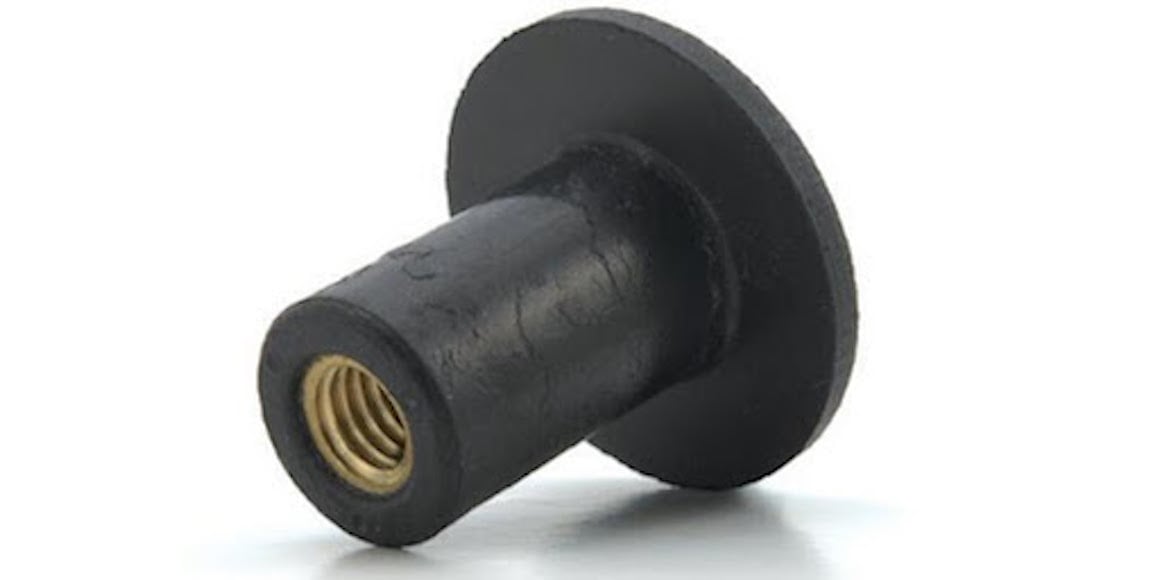
Threaded rivet nut inserts are a specific type of fastener designed to provide a threaded hole that can accept a bolt or threaded fastener. As with any type of fastener, there is more than one configuration, each designed for specific applications. The well nut is just one threaded rivet nut insert with a unique design and was created for particular uses.
There are times when you want a threaded insert that can not only accept a bolt but also creates a waterproof or airtight seal. Any blind fastener will make some kind of seal on the blind side of a joint, typically by collapsing the rivet shaft on the blind side. Even threaded blind inserts create a solid joint by collapsing the blind side as the bolt is tightened. However, conventional rivet nut inserts won’t seal the hole and may not tolerate heavy vibrations. That’s when you need a well nut.
Unlike other fasteners made of metal, a well nut is made of rubber or neoprene, forming a tight gasket when installed. Well nuts are designed to seal and resist vibrations, so they won’t loosen over time. These characteristics make threaded well nuts ideal for specific applications.
What is a Well Nut?
Sometimes called a jack nut, a well nut is a unique fastener for unique applications. Well nuts were originally developed by the United Shoe Machinery Company and are made of rubber with a flange at one end. Inside the well nut is a threaded insert usually made of brass or some other metal to accept a threaded bolt.
Like other fasteners, the well nut fits into a pre-drilled hole. The well nut expands when the bolt is tightened inside the threaded rivet nut, so the rubber forms a watertight or airtight seal. Once set, well nuts resist vibration and are waterproof, so they are popular for applications such as mounting engine parts or use with machinery.
Well nuts are installed just like any other fastener. Installation starts with a pre-drilled hole in the workpiece. The well nut is then passed through the hole with the flanged end on top. Once it’s set in the hole, the bolt is screwed into the brass insert, which expands and makes a tight, vibration-resistant hole against the sides of the bolt hole.
Where are Well Nuts Used?
Well nuts are often used in applications that require a tight seal. For example, well nuts are used in marine applications, such as building boats. They are also used to build water tanks and similar applications since well nuts perform well with softer and more brittle materials, such as plastics and glass.
While well nuts are designed to provide a reliable seal, they are not entirely foolproof. The rubber in a well nut dries out and cracks over time, which will impact the integrity of the seal. Salt water, for example, can reduce the life of a well nut. Well nuts may also fail under extreme pressure, which may deform the rubber and cause it to lose its seal. If the bolt with the well nut loosens, it can also affect the seal.
Well nuts are also used in the manufacture of factory equipment, automobiles, power tools, and in other applications where it pays to use a vibration-resistant fastener. Well nuts are useful for equipment manufacturing since they make it easy to replace and secure parts using a wrench. When a well nut wears out, it is easy to replace.
However, well nuts are not suitable for every fastener application. For applications where having a seal or resisting vibrations are not concerns, other types of fasteners, such as rivet nut inserts provide a longer-lasting joint. They are much stronger and are not as prone to pullout as well nuts.
How Do You Choose the Right Well Nut?
Well nuts come in different types, sizes, and materials from various fastener manufacturers. You typically choose well nuts by width, length, and thread size. Other considerations include the flange size, diameter, height, and grip range. Well nuts are available from well-known fastener brands, including POP, Marson, and Bayfast.
Since well nuts accept conventional bolts, they can also be installed using conventional tools, such as a socket wrench or power drill. Once the well nut is set, simply insert the bolt and tighten it to set the well nut and form a seal. Since well nuts are made of rubber or neoprene, be careful not to use too much torque during installation, which could damage the well nut or the threaded well nut sleeve.
Choosing the right well nut for the task doesn’t have to be complicated. If you are interested in learning more about the types of well nuts available, be sure to take a moment and sign up for the Bay Supply Marketplace. Registration is free, and you gain access to fastener products from manufacturers and distributors worldwide.




Comments